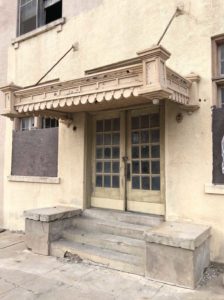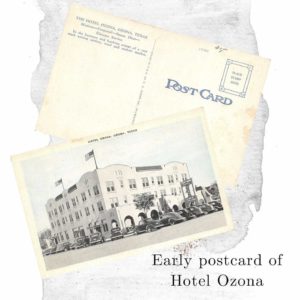Skip to content

While taking photos of the county courthouse in Ozona, I turned around to see the remains of Hotel Ozona, and couldn’t resist getting a closer look. Obviously once a beautiful hotel and it was easy to imagine it surrounded by cars and people carrying in their finest leather luggage for a stay along a road trip adventure.
 Ozona is a fairly small town, but its position along the Old Spanish Trail would have brought a lot of visitors a few decades ago.
Ozona is a fairly small town, but its position along the Old Spanish Trail would have brought a lot of visitors a few decades ago.
The Old Spanish Trail (also known as OST to many Texans), was a 2,750 mile long roadway that reached from ocean to ocean – St. Augustine, Florida to San Diego California. The headquarters for the project was in San Antonio, where an executive committee of prominent businessmen met weekly at the Gunter Hotel from 1915 until it was completed in the 1920s.

Perfectly timed for a nation that was enjoying a newfound enjoyment of “auto touring,” hotels and restaurants began appearing long the route just as they did later on Route 66. If traveled from one end to the other, tourists would cross eight states and 67 counties along the Southern United States!
Although promoters for the OST claimed that it followed the route used by Spanish Conquistadors 400 years earlier, there wasn’t actually a continuous trail from Florida to California that long ago.
The three-story Hotel Ozona was built in 1927 for $150,000 from reinforce concrete, hollow tile and stucco, to provide stylish accommodations for the influx of tourists coming through the area. The hotel was a busy center of social life for the community for the next twenty years as well, hosting conventions, luncheons, bridge clubs, organization meetings. wedding receptions and more. The Comanche Ramblers, Fort Stockton’s string band, played for old time dances in the ballroom.
But the party didn’t last forever. In 1948 notices appeared in Texas newspapers advertising the 41-room hotel and its newly equipped kitchen for sale for a mere $8,500, due to the dissolution of a partnership. Travelers along the OST lightened in favor of other, newer highways resulting in many of the once-thriving businesses along its path to close down.
For whatever reason, the Hotel Ozona closed its doors, and never reopened. A peek in the few windows that aren’t boarded up don’t reveal many distinctively original design features other than the from desk, stairway and wrought iron railings.
The old neon sign touting air-conditioned rooms still stands tall, minus most of the neon. 
So she sits and wait for someone to come to her rescue. With the revival of so many older properties in recent years, I’m crossing my fingers that her patience will pay off.


Who could resist pulling over to see this amazing hotel?
Danish-born Jules Leffland, the most famous architect in Victoria during the Victorian era, designed the the historic Hotel Blessing in Blessing, Texas. He adapted his take on Mission Revival style into wood construction instead of the traditional adobe or plater over brick.
Amazingly, the original blueprints drawn and signed by Leffland were discovered in the attic of the historic Abel Pierce home in Blessing in 2005.

The town of Blessing was established on property belonging to Jonathan Edwards Pierce, who granted a right-of-way to the Galveston, Harrisburg and San Antonio Railroad to increase commerce.

So why isn’t the town named Pierce?
The businessman was so relieved to get a town to ship his cattle that he had suggested the name “Thank God,” but postal authorities considered that somewhat blasphemous. Blessing was suggested and the post office opened in 1903.
Between 1903 and 1905 a library building was attached to the train station, and in 1905 the St. Louis, Brownsville and Mexico Railway also built through Blessing.

One of the oldest remaining buildings in town, Hotel Blessing has served as a community gathering place since it opened in 1907 when G. H. Crandall from Wisconsin was the manager.

Pierce and his son Abel built the hotel to provide lodging for new settlers, traveling salesmen and as a home for himself. The elder Pierce resided on site until his death in 1915.

The hotel was refinished and painted in the 1930s. During World War II wives and girlfriends of soldiers at Camp Hulen in Palacios would often stay at the inn. After the war ended the camp closed, freight train service stopped and eventually the hotel stopped renting rooms in 1972.


In 1977, Able Pierce, Jonathan Pierce’s grandson, and his wife Ruth renovated and reopened the hotel. The hotel was deeded to the Blessing Historical Society, which currently takes care of its operation. The hotel has 25 rooms, most which have a semiprivate or shared bathroom in a hall.

These days Hotel Blessing is widely known for food rather than overnight stays. Walk past the original registration desk, down a hall lined with screen-doored rooms and across the creak y floors, and enter the dining room You can count on bountiful breakfasts and a famous $10 lunch buffet with immense trays and pots of chicken fried steak, chicken, green beans, corn, breads, and more. Going away hungry just isn’t an option!
y floors, and enter the dining room You can count on bountiful breakfasts and a famous $10 lunch buffet with immense trays and pots of chicken fried steak, chicken, green beans, corn, breads, and more. Going away hungry just isn’t an option!
Generations of visitors and locals have spent countless hours in the dining room/coffee shop enjoying tasty, home-cooked meals and discussing local events.

The hotel is rightly proud to be the first building in Matagorda County ever listed on the National Register of Historic Places, earning that honor in 1979.

If you’re within a couple of hours of Blessing treat yourself to a leisurely lunch and then go down to the nearby shore to sit back and let your meal settle. It makes a great daytrip for family or friends.



 Ozona is a fairly small town, but its position along the Old Spanish Trail would have brought a lot of visitors a few decades ago.
Ozona is a fairly small town, but its position along the Old Spanish Trail would have brought a lot of visitors a few decades ago.














 y floors, and enter the dining room You can count on bountiful breakfasts and a famous $10 lunch buffet with immense trays and pots of chicken fried steak, chicken, green beans, corn, breads, and more. Going away hungry just isn’t an option!
y floors, and enter the dining room You can count on bountiful breakfasts and a famous $10 lunch buffet with immense trays and pots of chicken fried steak, chicken, green beans, corn, breads, and more. Going away hungry just isn’t an option!


